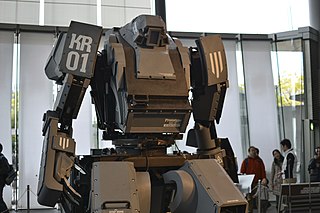
In science fiction, mecha or mechs are giant robots or machines typically depicted as piloted and as humanoid walking vehicles. The term was first used in Japanese after shortening the English loanword 'mechanism' or 'mechanical', but the meaning in Japanese is more inclusive, and 'robot' or 'giant robot' is the narrower term.

Sony Group Corporation, formerly known as Tokyo Tsushin Kogyo K.K. and Sony Corporation (ソニー株式会社), is a Japanese multinational conglomerate corporation headquartered in Minato, Tokyo, Japan. The Sony Group comprises entities such as Sony Corporation, Sony Semiconductor Solutions, Sony Entertainment, Sony Interactive Entertainment, Sony Financial Group, and others.
AIBO is a series of robotic dogs designed and manufactured by Sony. Sony announced a prototype Aibo in mid-1998, and the first consumer model was introduced on 11 May 1999. New models were released every year until 2006. Although most models were dogs, other inspirations included lion cubs, huskies, Jack Russell terriers, bull terrier, and space explorers. Only the ERS-7, ERS-110/111 and ERS-1000 versions were explicitly a "robotic dog", but the 210 can also be considered a dog due to its Jack Russell Terrier appearance and face. In 2006, AIBO was added into the Carnegie Mellon University Robot Hall of Fame.
An autonomous robot is a robot that acts without recourse to human control. The first autonomous robots environment were known as Elmer and Elsie, which were constructed in the late 1940s by W. Grey Walter. They were the first robots in history that were programmed to "think" the way biological brains do and meant to have free will. Elmer and Elsie were often labeled as tortoises because of how they were shaped and the manner in which they moved. They were capable of phototaxis which is the movement that occurs in response to light stimulus.

CES is an annual trade show organized by the Consumer Technology Association (CTA). Held in January at the Las Vegas Convention Center in Winchester, Nevada, United States, the event typically hosts presentations of new products and technologies in the consumer electronics industry.

QRIO was a bipedal humanoid entertainment robot developed and marketed by Sony to follow up on the success of its AIBO entertainment robot. QRIO stood approximately 0.6 m tall and weighed 7.3 kg. QRIO's slogan was "Makes life fun, makes you happy!"

Teleoperation indicates operation of a system or machine at a distance. It is similar in meaning to the phrase "remote control" but is usually encountered in research, academia and technology. It is most commonly associated with robotics and mobile robots but can be applied to a whole range of circumstances in which a device or machine is operated by a person from a distance.

Swift Engineering is an American spacecraft engineering firm that builds autonomous systems, helicopters, submarines, spacecraft, ground vehicles, robotics, and composite parts. The Chairman and CEO is Hiro Matsushita the former racecar driver and grandson of the founder of Panasonic, Konosuke Matsushita. Swift used to produce racing cars for open-wheel racing series, including Formula Ford, Formula Atlantic, the Champ Car World Series and Formula Nippon, having designed and fabricated over 500 race cars. Swift is AS9100, ISO 14001, and ISO 27000 certified.

The P series is a series of prototype humanoid robots developed by Honda between 1993 and 2000. They were preceded by the Honda E series and followed by the ASIMO series, then the world's most advanced humanoid robots. Honda Motor's President and CEO Hiroyuki Yoshino, at the time, described Honda's humanoid robotics program as consistent with its direction to enhance human mobility.

The history of robots has its origins in the ancient world. During the industrial revolution, humans developed the structural engineering capability to control electricity so that machines could be powered with small motors. In the early 20th century, the notion of a humanoid machine was developed.

Nao is an autonomous, programmable humanoid robot formerly developed by Aldebaran Robotics, a French robotics company headquartered in Paris, which was acquired by SoftBank Group in 2015 and rebranded as SoftBank Robotics. The robot's development began with the launch of Project Nao in 2004. On 15 August 2007, Nao replaced Sony's robot dog Aibo as the robot used in the RoboCup Standard Platform League (SPL), an international robot soccer competition. The Nao was used in RoboCup 2008 and 2009, and the NaoV3R was chosen as the platform for the SPL at RoboCup 2010.
Tomotaka Takahashi is a Japanese roboticist and founder of Kyoto University's ROBO-GARAGE since 2018. Takahashi creates humanoid robots known for their smooth, fluid motions and sleek appearance. Having built many humanoid robots entirely by himself, from simple concepts to production, Takahashi's designs have been featured in several art exhibitions celebrating the creation of Astroboy, Time Magazine's Coolest Inventions of 2004, and promotions for Bandai, Panasonic, and Pepsi. He has also worked with toy companies to produce relatively inexpensive robots for the hobby market, including those for Kyosho.
The following outline is provided as an overview of and topical guide to robotics:
Cloud robotics is a field of robotics that attempts to invoke cloud technologies such as cloud computing, cloud storage, and other Internet technologies centered on the benefits of converged infrastructure and shared services for robotics. When connected to the cloud, robots can benefit from the powerful computation, storage, and communication resources of modern data center in the cloud, which can process and share information from various robots or agent. Humans can also delegate tasks to robots remotely through networks. Cloud computing technologies enable robot systems to be endowed with powerful capability whilst reducing costs through cloud technologies. Thus, it is possible to build lightweight, low-cost, smarter robots with an intelligent "brain" in the cloud. The "brain" consists of data center, knowledge base, task planners, deep learning, information processing, environment models, communication support, etc.

Nicolaus Adam Radford known as Nic Radford is an American engineer, roboticist, inventor, and entrepreneur raising over $250mm in funding for his companies. He is the former president and CEO of Nauticus Robotics, Inc. (NSADAQ:KITT) a robotics firm he co-founded. He also founded Jacobi Motors, his company spun out of HMI to commercialize his variable flux motor research from graduate school. He also started Rad Capital Ventures to invest in the trading of electricity. Prior to forming HMI, he spent 14 years at Lyndon B. Johnson Space Center's Dexterous Robotics Laboratory at NASA in Houston, Texas. Radford was the principal investigator tasked with leading the development of Valkyrie for participation in the 2013 DARPA Robotics Challenge (DRC) and NASA's future Mars robotics missions.

Argo AI LLC was an autonomous driving technology company headquartered in Pittsburgh, Pennsylvania. The company was co-founded in 2016 by Bryan Salesky and Peter Rander, veterans of the Google and Uber automated driving programs. Argo AI was an independent company that built software, hardware, maps, and cloud-support infrastructure to power self-driving vehicles. Argo was mostly backed by Ford Motor Co. (2017) and the Volkswagen Group (2020).
aiMotive is an autonomous vehicle technology company. The company aims to work with automotive manufacturers and Tier1s to enable automated technologies. aiMotive describes its approach as "vision-first", a system that primarily relies on cameras and artificial intelligence to detect its surroundings. The technology is designed to be implemented by automobile manufacturers to create autonomous vehicles, which can operate in all conditions and locations. In September 2017, PSA Group teamed up with AImotive.

Yandex self-driving car is an autonomous car project of the Russian-based technology company Yandex. The first driverless prototype launched in May 2017. As of 2018, functional service was launched in Russia with prototypes also being tested in Israel and the United States. In 2019, Yandex revealed autonomous delivery robots based on the same technology stack as the company's self-driving cars. Since 2020, autonomous robots have been delivering food, groceries and parcels in Russia and the United States. In 2020, the self-driving project was spun-off into a standalone company under the name of Yandex Self-Driving Group.
The Sony Vision-S is an all-electric automobile platform that was developed by Sony, with the first model unveiled at the 2020 Consumer Electronics Show (CES) in Las Vegas as the Vision-S Concept. When the second concept was unveiled in 2022 as the Vision-S 02, the original concept was retroactively renamed to Vision-S 01. Sony plans to use the Vision-S platform to develop future electric vehicles under a new wholly-owned subsidiary, Sony Mobility Inc., which will assume responsibility for the Vision-S platform and vehicle development in the spring of 2022. The Vision-S platform is fully electric and designed to emphasize the user experience of autonomous driving, as well as accommodate the growth of technology in future models.
Sony Honda Mobility Inc. is a Japanese joint venture automotive company established by Sony Group Corporation and Honda Motor Company in 2022 to produce battery electric vehicles. The company will market its vehicles under the Afeela brand.












